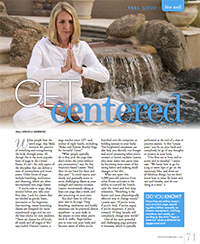 When people hear the word yoga, they often think of the physical practice of stretching and strengthening the body through postures. Although this is the most popular form of yoga in the United States, it is only one of many ways to achieve a state of centeredness and inner peace. Other forms of yoga include breathing, meditation and chanting, which are often incorporated into yoga classes.
When people hear the word yoga, they often think of the physical practice of stretching and strengthening the body through postures. Although this is the most popular form of yoga in the United States, it is only one of many ways to achieve a state of centeredness and inner peace. Other forms of yoga include breathing, meditation and chanting, which are often incorporated into yoga classes.
If you’re new to yoga, shop around before you take your first class. Look for classes that are labeled as gentle, beginners, basics or restorative. Fast-moving, sweat-drenching yoga classes are designed for more experienced yogis and are not the best choice for new students.
“There are classes for all levels, all needs and all stages of life,” says Judith Hanson Lasater, Ph.D., PT, yoga teacher since 1971 and author of eight books, including, “Relax and Renew: Restful Yoga for Stressful Times.”
“What people typically do is they pick the yoga class that’s down the street without any preparation,” says Lasater. “And then it’s too hard for them and they quit.” To avoid injury, start slowly and gradually move to more challenging classes as your strength and stamina increase. Lasater recommends taking at least one yoga class a week and also practicing on your own.
You don’t have to roll out your mat to do yoga. Deep breathing, meditation and bodily awareness can be practiced almost anywhere – at your desk, in the airport or even when you’re stuck in traffic. Yoga teaches you to tune into your body and become aware of when you’re hunched over the computer or holding tension in your body. This heightened awareness can also help you identify true hunger and avoid overeating when you’re stressed or bored, explains Lasater, who lost two pants sizes by becoming more aware of her eating habits and making small changes to her diet.
What sets apart this 5,000-year-old practice from other fitness activities is the ability to control the breath, calm the mind and find deep relaxation.
“Breathing is the fastest and most physiologically effective way to change mood,” says Lasater. “If you’re tense, if you’re tired, if you’re angry, if you’re impatient, if you’re stressed, ten deep breaths will completely change your world.”
One of the most powerful yet challenging yoga postures is Savasana, performed at the end of your practice, in which you lie down on your back in stillness and completely let go of any thoughts or tension in the body.
“Our lives are so busy and so active and so stressful,” says Lasater. “We know how to go for a jog or swim laps or get on the stationary bike, and those are all fabulous things, but we don’t know how to relax, lie down and rest and breathe, and do one thing at a time.”
Did You Know
More than 20 million Americans practice yoga, spending $10.3 billion annually on classes, equipment, clothing, vacations and media, according to the 2012 “Yoga in America” Market Study.